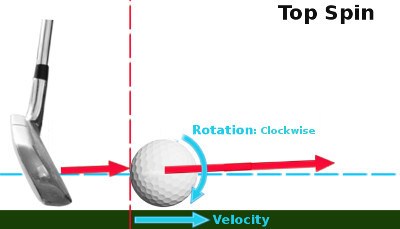
What do you do when faced with a long chip-and-run, were there's lots of green between your ball and the cup?
Many of us reflexively reach for a less lofted club, like a 6- or 7-iron, to get the ball onto the green quickly and rolling toward the target. Sometimes, however, that's not the proper play.
A prime example is when there's a rise or ridge just in front of you. Maybe the green is elevated, or you've come up short of a false front. Whatever the case, if you hit the ball too low it may bounce into the upslope and quickly lose momentum, stopping well short of the hole or even rolling back to your feet.
One option is to pitch the ball over and beyond the ridge, relying on backspin to stop it by the hole. But this requires landing the ball in a precise area and hitting it cleanly, raising the degree of difficulty. A better play is to compromise between the pitch and your normal chip-and-run using a gap wedge (typically 51-54° loft).
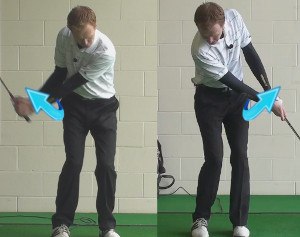
Here's how to execute the shot:
- Choose your target line align the club directly at it.
- Stand with your feet slightly closed, aimed just right of the target.
- Play the ball in the center of your stance with the hands just ahead of the ball.
- As you swing, allow the right hand to cross or roll over the left through impact. This will impart a tiny amount of topspin which gets the ball running after it lands.
By using the gap wedge instead of a 6- or 7-iron, you'll hit the ball a little higher and clear the ridge. By releasing the club, you'll get the roll needed to reach the cup. The release is critical; if you hold the face open through impact, backspin will cause the ball to check up on the green. Try to finish with the club's toe pointing up.
If your set doesn't include a gap wedge, the technique works with the pitching or sand wedge as well.
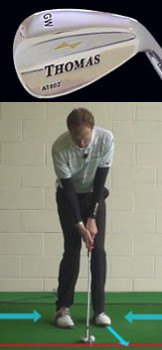
Use Gap Wedge to Hit Long Chips with Topspin
The long chip shot is one of the most challenging shots in golf. Anytime you have to cover a longer-than-usual distance with a short game shot, you will know you need to bring your best stuff in order to succeed. It is hard to control short game shots when they travel more than 10 or 15 yards, largely due to the number of variables in play - such as the firmness of the turf, the speed of the greens, and more. Additionally, this is a shot that most amateur golfers fail to practice, which leads to even more trouble. If you would like to get up and down more frequently when facing a long chip shot, learning how to hit the 'topspin' gap wedge is a great idea.
The word topspin is in quotation marks above because this shot really doesn't have topspin - all golf shots have some degree of backspin. However, since this shot has much less backspin than your typical chip shot, it might feel like you are using topspin to get the ball close to the hole. There is nothing wrong with calling this a topspin chip or pitch, but you should at least be aware of the fact that the ball isn't actually spinning toward the hole as it flies.
Adding this shot to your short game repertoire is a nice idea because it will simply give you one more option to reach for when trying to get up and down. You are going to face an infinite number of different situations around the greens as you move forward in the game, and having as many different shots as possible in your arsenal key to your success. The short game would be relatively easy if you only needed to hit one kind of shot, but that just isn't how it works. Variety is critical when it comes to the short game, so adding this gap wedge topspin shot to the options you have at your disposal should help you save a stroke from time to time.
As is always the case in golf, you are going to have to invest some practice time in this shot if you want it to work for you out on the course. If you were to just read the instructions on how to hit the shot and then decide to try it out during a round with no preparation, the results would almost surely be disappointing. The practice step is huge in this equation, so you shouldn't plan on using this during a round until the prep work has been done to fine tune your mechanics.
All of the instruction below is based on a right handed golfer. If you happen to play golf left handed, please take a moment to reverse the directions as necessary.
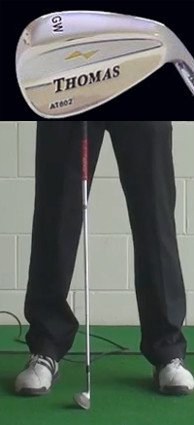
What is a Gap Wedge?
Before we get too far into the specifics of how to hit this shot, we should take a moment to highlight exactly what a gap wedge is, and why you should consider having one in your bag. A gap wedge is so named because it is meant to fill the gap between your pitching wedge and your sand wedge. Often, the gap wedge will have around 52 degrees of loft, but the exact loft that you use will depend on the lofts of your other wedges. If you are in the market for a gap wedge, you should be sure to test out distances with various models to make sure you pick one that slots into your set nicely.
The gap wedge is an important component in the makeup of your set as a whole because it allows you to handle more approach shot yardages with a comfortable swing. If you didn't have a club in this loft range, you would be forced to either hit a hard sand wedge or a very soft pitching wedge when you face yardages that land in this area - and those shots can be difficult to pull off successfully. You want to have a full swing into the target as frequently as possible when hitting approach shots, and carrying a gap wedge will take you closer to that goal.
Of course, in addition to full shots, a gap wedge is perfectly capable of hitting chip and pitch shots around the green. It makes a nice addition to your set of clubs from this perspective as well, since you will now have an option to turn to that provides more roll out than a sand wedge but less than a pitching wedge. Again in the short game, this club fills the 'gap' beautifully. Once you spend some time practicing short game shots with this club, you will likely find yourself reaching for it on a regular basis.
There is no requirement that your gap wedge has to match with the rest of your wedges, but many golfers like to use the same make and model throughout their set of wedges for consistency. If you already have a good feel for your sand wedge, for example, it would only make sense to pick up the same style of club for your gap wedge. However, if you can't find a gap wedge that does match your current set, don't worry - many golfers have had great success by simply finding a wedge that they like and learning how to use it one practice shot at a time.
Some golfers decide to dump their gap wedge in favor of an extra long club, such as a hybrid or even a long iron. This is usually the wrong way to go. You have to play short shots far more frequently than you play long shots, and the short shots you play need to be more accurate from a distance perspective than the long swings. Having an extra wedge is almost always going to be more productive than having an extra long club, so think carefully before you leave that useful gap wedge at home for your next round.
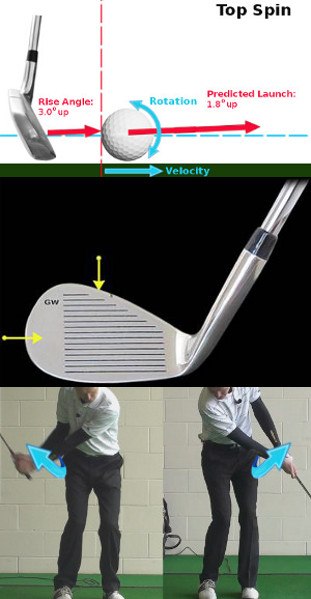
The Basics of the Long Topspin Chip
To get started with this shot, you are going to need to understand the basic fundamentals of the technique required to produce a chip shot that has a low spin rate and plenty of roll after it lands. Of course, before the club can go in motion, you have to be set up over the ball correctly. The following points all need to be present in your setup if you are going to produce the long topspin chip.
- Closed club face. This is, in many ways, the key to the entire shot. If you would like to keep the spin off the ball, and you would like to keep the ball low to the ground so it can roll out after it lands, you want to close down the face of the club at address. Should you decide to play the shot with the face squared up to the target, there will be too much loft in play at impact and the shot will have more spin than you would like. Be sure to adjust the angle of the face prior to taking your final grip - otherwise, the face will simply open back up when you start the swing, and you won't be able to create the low flight you need.
- Ball back in your stance. This one probably goes without saying, but you need to play the ball well back in your stance if you want to hit a topspin chip. Try lining the ball up with the inside of your right foot when you address the shot. After you have hit a few practice shots, feel free to adjust your ball position slightly forward or back to achieve the desired results. However, the ball should never make it all the way up to the middle of your stance when using this shot to chip from around the green.
- Hands in front of the ball. You should naturally have your hands in front of the ball when you play the ball back in your stance, but this point is worth highlighting anyway just to be sure. By setting your hands at least a few inches in front of the ball at address, you will be promoting a downward strike at impact - which is going to be important later on when you start to actually swing the club. This point should be easy to check, as you simply need to look down while in your stance to ensure that the handle of the club is closer to the target than the ball. If that is the case, you can move on to worrying about other aspects of your technique.
That's it - if you can simply put those three setup tips into play when you get over the ball, you will be ready to hit this shot properly. If you would like, you could even practice your setup for this shot before you ever go to the course for an actual practice session. Find a place around your house where you can look in a mirror while setting up over an imaginary chip shot. You aren't going to swing the club at all, or even have a ball down in front of you while practicing your address position. Just take your stance, check your positions, and repeat. By doing this work in advance, you will already be comfortable with your stance before ever getting to the golf course.
There is one other part of the setup that should be touched on briefly, and it has to do with grip pressure. As you stand over the ball, make sure your grip is relaxed and comfortable on the club. You should not be squeezing tightly on the handle, as you want the club the to be able to move freely throughout the chipping motion. With a light grip and plenty of feel in your fingers, it will be easier to perform a free swing that results in clean contact time after time. Of course, you should be using a light grip pressure on all of the shots that you hit during a round, but it is particularly important here because you need the club to release through impact if you are going to get the shot to run out correctly.

Making the Swing
With the prep work out of the way and a gap wedge in your hands, it is time to actually hit some shots. Of course, you will need to be at the golf course for this part of your practice, and you are going to want to have plenty of room to work with around the practice chipping green. For your first topspin chip shots, try setting up somewhere around 20 or 30 yards from the hole. This shot can be used from a variety of distances once you get the hang of it, but that will be a good range for you to get started. Give yourself a nice lie in the fairway as well - you don't need to complicate things at this point by playing from the rough. Once you learn the basic mechanics, you can mix in tougher lies to make the shot even more useful.
Since you already know how to hit a basic chip shot, we won't go through the full step-by-step process of swinging the club at this point. Generally speaking, this shot is going to be played with the same type of swing as your usual chip shot, only with a few modifications. Read through the list below to see how this topspin chip is going to vary from your typical chip or pitch shot from around the green.
- No follow through. One of the important keys to keep in mind is that there should be almost no follow through with this kind of shot. The club should come to a stop almost immediately after you make contact with the ball. Why is this important? The lack of a follow through signifies an aggressive downward hit, as the ground will have absorbed most of the speed of your swing after the ball is sent on its way. If you are finding that the club wants to naturally follow through toward the target, work on moving the ball back a bit in your stance. Moving the ball back will make it easier to hit down, and you should find that your follow through quickly disappears.
- Left shoulder down. When you are trying to get the ball up into the air with a chip or pitch shot, you may need to move your left shoulder up away from the ground in order to add loft through impact. That technique is fine for those higher shots, but it isn't going to work when you want to keep the ball and spin rate down. As you are swinging through the ball, focus on keeping your left shoulder down all the way through the shot. That shoulder staying down is a sure sign that you are staying down on the ball nicely, and it should help dramatically in creating the low flight that you need.
- Keep the club low to the ground. It is common to use some wrist action in the backswing of a normal chip shot to elevate the club off of the ground. That is considered good technique most of the time, but not necessarily in this case. When trying to hit a topspin chip across the green, work on keeping your wrists out of the equation going back while keeping the club head lower to the ground. You still want to hit down on the shot, of course, but that will happen naturally due to the ball position you are using. Think of the technique for this shot as being something between a putting stroke and a regular chipping action. There is going to be more wrist action in this swing than when putting, but not as much as you would use when chipping the ball up into the air.
As you can see, the modifications required to your chipping technique are not significant. When you get down to work on hitting some low, running chip shots with your gap wedge, focus on these three points in order to transform your usual chipping action into one that will create the desired ball flight. Unlike changes to your full swing, which can take a very long time to take effect, these changes should be pretty quick and easy to 'install'. Spend some time during each practice session hitting at least a few of these shots and it will become a trusted part of your repertoire in the very near future.
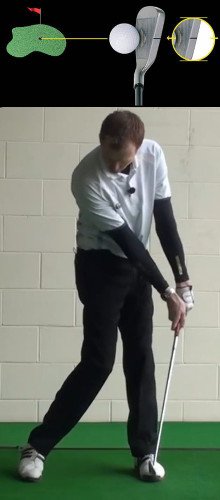
The Issue of Alignment
Earlier, it was mentioned that the face of your gap wedge needs to be closed down at address in order to hit this shot. Turning the face down will take loft off of the club, producing the lower launch that you would like to see when hitting a chip and run such as this. Of course, when you turn the face down to the left to reduce loft, you are going to throw off your usual alignment. If you fail to account for the change in face angle when you take your stance before hitting the shot, you will inevitably miss to the left of the target time after time. To avoid this fate, you need to understand how to adjust your alignment properly to leave the clubface pointed perfectly at the target.
The best way to ensure you are aligned correctly with the target prior to hitting a chip shot is to aim the face first, and then set your body to match. As you walk up to the ball, keep your feet in a casual stance to the side of the ball while you work on setting up the clubhead. Remember to keep the clubface closed at this point to reduce the loft on the gap wedge, and take care to align the face perfectly with your selected target. You only get one chance to get this crucial point right, so take your time and only move on when you are sure you have the face pointed in the right direction.
After the face has been set, the next step is to put your body into place. Of course, you need to be careful to maintain the face position you worked so hard to create in the previous step. If the club head moves now, you will have undone the work you just did. While holding the club head perfectly still behind the ball, put your feet into place and complete the rest of your address position. You may need to practice the process of getting ready to hit this kind of pitch shot before you are able to do it confidently on the course. When practicing, don't just hit a bunch of shots in a row – step back after each shot so you can repeat the process of getting lined up accurately. Since the ball isn't going to curve in the air with this kind of low chip, your alignment is going to be the biggest piece of the puzzle in terms of getting the ball on line with the target. Take this part of the shot seriously and you will be rewarded.
The topspin chip across the green is a great play when you need plenty of roll and you have a lot of green to work with. This shot is limited in its usefulness – you aren't going to play it when you are short sided, or when you are playing down a steep slope – but it is still worth taking the time to learn how to execute it correctly. Once the initial work is done and you are comfortable with the technique involved, you can begin to use this shot on the course when the right opportunity comes along.






